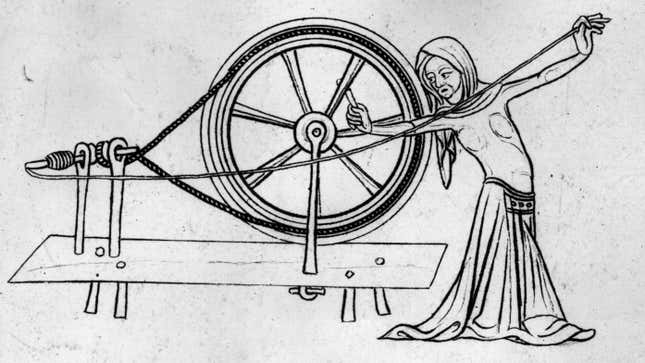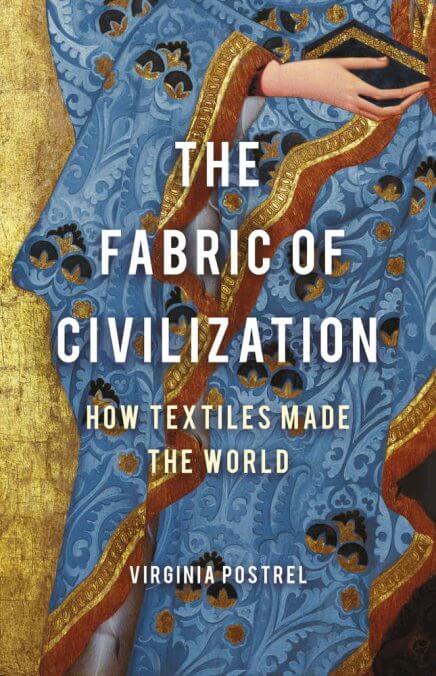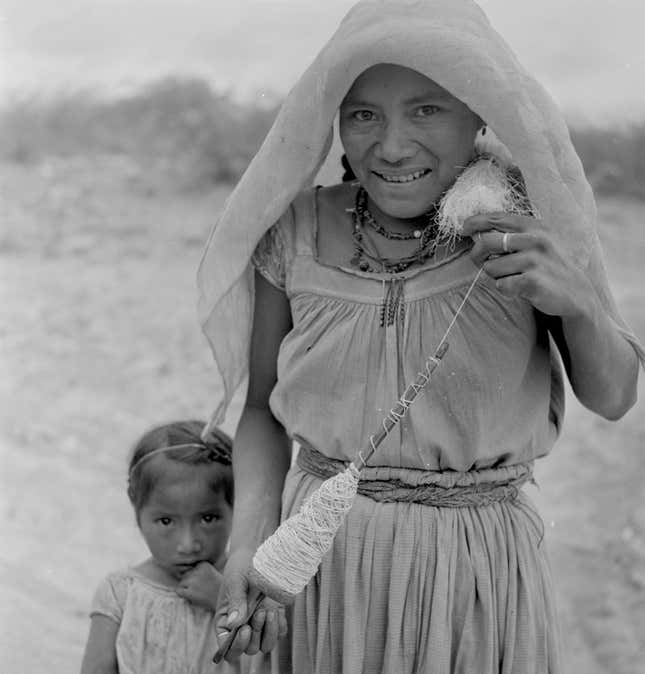The Centuries-Old Symbolism of a Woman at Her Industrious, Somewhat Sexual Spinning
In Depth
Image: (Photo by Hulton Archive/Getty Images)
A spindle whorl doesn’t look like much. It’s a small cone, disk, or sphere made of a hard material such as stone, clay, or wood, with a hole through the center. Museums often own thousands but display only a handful to the public. Even these special few, singled out for their decorative paint or engraving, are easily overlooked in favor of the showier vases, bowls, and statuettes nearby. “Spindle whorls are not the most spectacular objects found by archaeologists,” concedes a researcher. They are, however, among the earliest and most important human technologies—a simple machine as essential as agriculture in going from small amounts of string to the large quantities of yarn needed for making cloth.

“The spindle was the first wheel,” Elizabeth Barber tells me, gesturing to demonstrate. “It wasn’t yet load bearing, but the principle of rotation is there.” A linguist by training and weaver by avocation, Barber started noticing footnotes about textiles scattered through the archaeological literature in the 1970s. She thought she’d spend nine months pulling together what was known. Her little project turned into a decades-long exploration that helped to turn textile archaeology into a full-blown field. Textile production, Barber writes, “is older than pottery or metallurgy and perhaps even than agriculture and stock-breeding.” And textile production depends on spinning.
Leaving aside silk, which we’ll get to later, even the best plant and animal fibers are short, weak, and disorderly. Flax fibers can reach a foot or two, but six inches is as long as a strand of wool will grow. Cotton typically runs only an eighth of an inch, with the most luxurious varieties extending no more than two and a half inches. Drawing out these short fibers, known generically as staple, and twisting them together—spinning, in other words—produces strong yarn, as individual fibers wind together in a helix, creating friction as they rub against each other. “The harder you pull length wise, the harder the fibers press against each other crosswise,” explains a biomechanics researcher. Spinning also extends the length of staple fibers, producing thread that can stretch for miles if needed—as it usually is.
Spindle whorls are the durable components of a two-part mechanism that, with slight variations, many different people invented in many different places, from China to Mali, the Andes to the Aegean. A stick goes through the hole, with the spindle whorl near one end. To make thread, a spinner stretches out a bit of fiber still attached to a clean mass of wool, flax, or cotton that has been brushed so that the strands run more or less in the same direction. She ties some twisted fiber around the rod, then drops the apparatus while setting it spinning. The whorl adds weight and increases the spindle’s angular momentum, allowing the spinner to maintain the rotation while continuing to add new fiber as gravity stretches the thread downward. When the string grows too long for her to hold it off the ground, the spinner winds the new yarn around the stick, preserving its twist. These three steps—drafting, twisting, and winding—together constitute the process of spinning yarn.
In the hands of an experienced spinner using well-prepared fiber, it looks effortless. The yarn seems to grow on its own. But spinning is quite tricky. You have to keep exactly the right tension on the continuous supply of new fiber—enough to make the thread fine and even, but not so much that it breaks off—while maintaining a steady amount of spin. In a six-hour drop-spinning workshop, with generous hands-on assistance, I managed to produce about ten yards of yarn of uneven, two-ply wool yarn. If that sounds impressive, picture a ball about an inch in diameter. Fine for knots. No good for cloth.

Once you get the feel for it, however, spinning becomes second nature. Hobbyists call it a stress reliever. “When you first begin,” says spinner Sheila Bosworth, “no one would ever believe it is calming and relaxing, but once you know what you are doing, the rhythm is very meditative.” Bosworth takes her drop spindle with her everywhere, spinning as she waits in line, sits in restaurants, or rides in the car.
In this, she mimics the countless generations who spun out of necessity. Using a drop spindle, preindustrial spinners could work while minding children or tending flocks, gossiping or shopping, or waiting for a pot to boil. They could spin indoors or out, in company or alone, in close quarters or open space.
Although not quite as portable, spinning wheels were often light enough to take outside in good weather. Renaissance Florence banned spinners from crowding its public benches. Traveling through Suffolk and Norfolk in the late seventeenth century, diarist Celia Fiennes observed women “at their wheeles out in the streets and Lanes as one passes.” In northern Europe, spinners brought their tools to communal “spinning bees,” sharing heat, light, and sometimes-raucous companionship on long winter nights. “Alone she does not earn her lighting costs” was how a German farmer’s wife in 1734 justified defying a local ban on such gatherings. For others, the attraction lay in the fellowship, including the young men who dropped by to flirt with the spinners.
Unlike other steps in textile production, spinning has almost always been done exclusively by women. “That woman alone is good who works all the time with the charkha,” or spinning wheel, wrote the Indian historian and poet Abdul Malik Isami in 1350. The English word distaff is both a tool to hold fiber while spinning and an adjective denoting something related to women, most often the mother’s or wife’s side of a family. Spinster means both someone who spins and an unmarried woman.

On ancient Greek pottery, spinning appears as both the signature activity of the good housewife and something prostitutes do between clients. “In the same manner that sex was the trade of the prostitutes, so too was the making of textiles,” writes an art historian. A similar contrast appears in sixteenth- and seventeenth-century European art. In expensive paintings like the 1529 portrait by Maarten van Heemskerck of Dutch citizen Anna Codde that hangs in Amsterdam’s Rijksmuseum, spinning exemplifies industry and virtue. In popular prints, it’s often sexually charged. A Dutch engraving from 1624 shows a young woman with a large, fiber-filled distaff—a pole whose contents give it an especially phallic shape—under her right arm. Her left hand fondles the fibers, holding the distaff’s bulging end unrealistically close to her face. Rather than drawing out fibers to spin, she seems on the verge of kissing them. The accompanying text transforms spinning into an extended sexual metaphor.
I am stretched long, white—so you see—and fragile. At the uppermost am I the head, slightly big. My mistress wishes me steady, often has me in her lap; or instead, she lays me nearby her side. She holds me many times—yes, daily, may I say, with her hands. She pulls her knees up, and in a rough place, now she sticks my top. Now she pulls it out again. Now she goes to place it again.
Virtuous or sexy, take your pick. Whatever a man wanted in a woman—or a woman aspired to be—spinning could represent it. Whether designed to valorize or titillate, these popular images reflected an everyday reality. Most preindustrial women spent their lives spinning. Unlike weaving, dyeing, or raising sheep, it was less a specific occupation than a universal life skill like cooking or cleaning. A poor woman might do it for money, just as she might hire out as a maid, but she had that option because she’d learned from childhood how to spin—and because there was always demand for more thread. Always.
Excerpted from The Fabric of Civilization: How Textiles Made the World by Virginia Postrel. Copyright © 2020. Available from Basic Books, an imprint of Hachette Book Group, Inc.